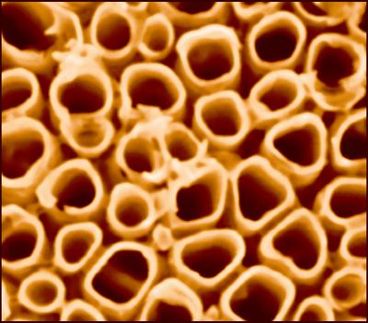Solar Cells Can Take the Heat
Binary ionic liquid electrolytes enable production of solvent-free solar cells
Advertisement
solar cells have attracted global attention as one of the cornerstones of alternative energy. In theory, it seems to make abundant sense to tap into the energy of the sun to convert light to electricity with little or no emission of noxious pollutants. However, in practical terms, progress has been slow because of technological impediments and the many different factors that need to be optimized to obtain stable and high-efficiency devices. Dye-sensitized solar cells based on dye molecules adsorbed onto titanium dioxide electrodes have emerged as one of the most attractive solar-cell constructs, combining low cost and relative ease of fabrication with high-efficiency performance. Indeed, state-of-the-art solar cells with this architecture show greater than 11% light-conversion efficiency. However, the catch is that these high-efficiency solar cells typically use volatile organic solvents as electrolytes, which essentially precludes their use in outdoor applications because of the high vapor pressure of the solvents. Solvent-free solar cells fabricated so far show poor performance owing to the high viscosity of the alternative electrolytes. Now, a team of researchers at the Ecole Polytechnique Fédérale de Lausanne in Switzerland have fabricated a solvent-free dye-sensitized solar cell based on a binary ionic liquid electrolyte. These devices show a light-conversion efficiency of 7.6% under simulated sunlight conditions, which sets a new record for a solvent-free device.
Shaik Zakeeruddin, Michael Grätzel, and their colleagues have used a mixture of two ionic liquids as the redox electrolyte in conjunction with a novel highly conjugated ruthenium-based dye to prepare a solvent-free solar cell. Ionic liquids essentially have a vapor pressure of zero, which makes them preferable even to robust and low-volatile organic solvents. However, the typically high viscosities of ionic liquids and the fact that most of the promising ionic liquids are composed of iodide ions have precluded their application in viable cells since iodide ions tend to have a deleterious impact upon the photoconversion efficiency by quenching the dye sensitizer. Grätzel and co-workers have tackled these challenges by adding in a low-viscosity ionic liquid comprising an inert anion. The low viscosity helps to overcome mass-transfer challenges, whereas the inert anion counteracts the deleterious influence of the iodide anions. The obtained solar cells show a record 7.6% conversion efficiency. More importantly, these cells are stable at 80 °C in the dark and under visible-light soaking at 60 °C for over a thousand hours, which points to the possibility of their use in outdoor applications in warm climates. The solvent-free nature of the electrolyte also suggests that it may be possible to construct flexible and lightweight devices based on these electrolytes.
"This is a big step in the search for nonvolatile electrolytes", said Zakeeruddin, adding that the performance of devices based on ionic liquids had lagged so far behind that it was widely thought that these systems would be limited to indoor applications at low lighting levels. Grätzel added that the results indicate that it should be possible to further optimize the performance of these solvent-free systems.
Original publication: Michael Grätzel et al.; "Stable, High-Efficiency Ionic-Liquid-Based Mesoscopic Dye-Sensitized Solar Cells"; Small 2007, 3, No. 12, 2094-2102.
Other news from the department science
Most read news
More news from our other portals
See the theme worlds for related content
Topic World Battery Technology
The topic world Battery Technology combines relevant knowledge in a unique way. Here you will find everything about suppliers and their products, webinars, white papers, catalogs and brochures.

Topic World Battery Technology
The topic world Battery Technology combines relevant knowledge in a unique way. Here you will find everything about suppliers and their products, webinars, white papers, catalogs and brochures.





























































